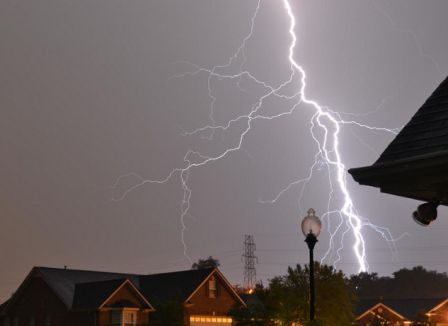Categories: How does it work
Number of views: 7670
Comments on the article: 0
What is active lightning protection
Active lightning protection is an electrical system that serves to artificially accept and discharge lightning current into the ground. The active lightning protection system is triggered when dangerous thunderstorm activity threatens with its natural development of a specific protected area. The system outperforms the independent development and formation of a lightning discharge in a natural way, and thereby protects a vast territory, much larger than conventional lightning protection methods.

To better understand how active lightning protection works, we turn to the basics of the theory of the occurrence and development of lightning and the principles of the organization of lightning protection systems.
What is lightning and what is lightning protection?
In general, linear lightning is an electric discharge in the atmosphere that occurs as a result of an increase in the electric field between the earth and clouds, or between objects on the earth and clouds. Lightning is actually a long spark that ignites and carries a charge when the intensity of this electric field becomes significant.
A typical discharge begins with the formation of a descending step leader, when a luminous channel begins to sprout from the cloud in the direction of the earth, it moves with jerks at an average speed of 28 to 280 meters per second. After a moment, an ascending leader from the earth is formed towards him. At the moment of meeting of these two leaders, the phase of the main discharge begins, which is what we perceive as lightning itself.

Due to lightning striking buildings, there is an increased risk of electric shock to people, the risk of melting and igniting various materials, splitting of wood, cracking in concrete and brick, and damage to electronics due to a discharge in the communications. Even if the discharge did not hit the wires directly, an overvoltage wave can propagate through communications for kilometers and damage equipment. According to statistics, up to 40% of fires occur due to lightning discharges.
External lightning protection using active lightning rods will protect objects from destruction due to direct lightning strikes. The main goal of active lightning protection is to take the blow on yourself and divert thunderstorm currents to the ground without the risk of damage to anything.
In general, any lightning protection system basically functions, developing a counter leader, greatly increasing the likelihood of lightning entering the air terminal. Moreover, all materials of the elements of the device are selected so that even if lightning currents flow through them, the integrity of the protected object and the integrity of the protection system would not be violated.
What is the main difference between active lightning protection and other types of traditional lightning protection devices?
The main difference is presence of an active air terminal. An active lightning rod reacts to an increase in the electric field strength during the approach of a thundercloud: capacitors are charged from the voltage that this field induces on the antenna devices, and when the voltage reaches 13000-14000 volts, an electrical breakdown occurs in the arresters, and the device forms a pulse with a voltage of more than 200,000 volts, while its polarity is opposite to the polarity of the lightning front taking place.

This impulse appears before a natural ascendant leader is formed, a start is given, ignition for the emergence of an artificial ascendant leader, which quickly develops over a long distance, covering a vast area protected by an air terminal.
Active lightning protection is especially useful in cases where the specificity of the protected object does not allow the use of other traditional lightning protection devices, for example, such objects as construction sites, seaports, crowded places, etc. There is evidence that active lightning rods helped protect against lightning from John Paul II at the service in 1998.

Active lightning protection systems do not violate the aesthetics of the protected objects, since they do not have massive parts, and installation work and material costs are minimal. The area of the protected zone covered by active lightning protection significantly exceeds the passive lightning rods of traditional structures of similar height.
In accordance with the standard NF C 17-102, active lightning protection almost 100% eliminates the defeat of the object protected by it with lightning. At the same time, the active lightning rod does not require power either from the mains or from the batteries, it is a fully autonomous device. The receiver is activated only when there is an objective risk of lightning.
When choosing active lightning protection, the level of protection required for a particular object is first determined. According to the standard NF C 17-102, to determine the level of protection proceed from the following conditions:
-
The collection area. The conditional replacement area of the territory on which there is a sufficient probability of malicious lightning striking the object. This area is connected by the shape and size of the object;
-
To assess the relevance of the installation of active lightning protection, take into account the ratio of the expected and recognized frequencies of damage to the object by lightning;
-
Estimate the location of the object. If the object is in a densely built-up area, then the probability of being struck by lightning is much less than for a single object located on a hill;
-
Take into account the dangers that may result from lightning directly into the object. Is the material of the walls and roof combustible, how many people are regularly at the facility, and what are the opportunities for their rapid evacuation, what is the cost of the facility, what are the possible environmental consequences of lightning. The level of protection required is determined taking into account all potential hazards.
When all the criteria are taken into account, and the level of protection of the object is determined, proceed to the selection of the model of the active lightning rod taking into account the height of its installation, as well as to the selection of components accompanying the system.
See also at bgv.electricianexp.com
:
